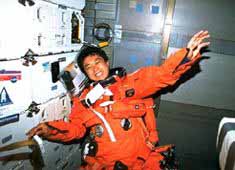|
Top Picks || Arts & Entertainment || Business & Economy || Education & Society ||
UP IN SPACE AGAIN: Female Astronaut First Japanese to Visit Space Twice October 12, 1998  Mukai is ready for another zero-gravity trip. (Courtesy of NASDA) Japanese astronaut Chiaki Mukai will become the first Japanese to travel to space twice when she joins the crew of the U.S. space shuttle Discovery in October 1998. She will be conducting a number of scientific experiments, as on her previous journey in 1994, and will also play an important role as the doctor for the space shuttle crew, which will include 77-year-old U.S. Senator and former astronaut John Glenn. Glenn will also be making his second trip to space--36 years after his initial visit. Mukai will be conducting observations on Glenn and gathering medical data as part of a study on the aging process. Glenn to Be Focus of Study on Aging This mission is attracting special attention due to the participation of John Glenn, a hero of American space exploration who in 1962 became the first American to orbit the Earth. What is the purpose of Glenn's mission this time around? According to space scientists, many of the changes that the body undergoes in a gravity-free environment, including bone and muscle atrophy, balance disorders, and sleep disturbances, are similar to the changes that occur as people enter old age. Space biomedical researchers and gerontologists believe that more research in these areas could shed light on how older people can live more productive lives, as well as help to reduce the number of individuals requiring long-term medical care in their later years. Mukai, a 46-year-old cardiovascular physician who served as a visiting scientist at NASA's Space Biomedical Research Institute from 1987 to 1988, will be monitoring Glenn's physiological reaction to space and comparing this data with that of the other astronauts. She will also be on hand to provide emergency medical treatment should such a need arise. Mukai served as an on-ground backup specialist for the Neurolab mission conducted aboard the space shuttle Columbia in April 1998. This time around, she will be performing about 30 experiments herself in the shuttle's research laboratory. Eight of these experiments are Japanese-sponsored, of which seven are related to the life sciences. One of these experiments will monitor the effects of space sickness on anglerfish. This will be the first time that electric signals in the brain cell fibers of a living organism will be monitored in space. The reaction to weightlessness of bean sprout roots and cucumber buds will also be observed, but not just aboard the shuttle. The National Space Development Agency of Japan (NASDA) will distribute experiment kits to 100 groups of Japanese elementary and middle school students, and plans to compare the children's results with those obtained aboard the shuttle. One NASDA official commenting on the mission says, "This flight will be shorter than Ms. Mukai's previous one, but her role will be much more significant."
 Edited by Japan Echo Inc. based on domestic Japanese news sources. Articles presented here are offered for reference purposes and do not necessarily represent the policy or views of the Japanese Government. Edited by Japan Echo Inc. based on domestic Japanese news sources. Articles presented here are offered for reference purposes and do not necessarily represent the policy or views of the Japanese Government.
|
